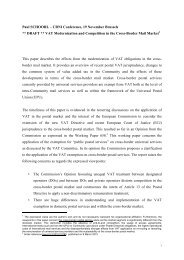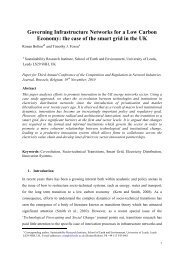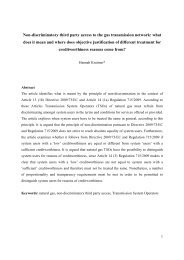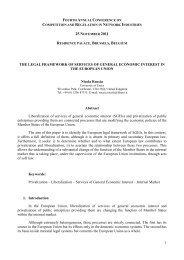Regulatory Incentives for Investments in Electricity Networks - CRNI ...
Regulatory Incentives for Investments in Electricity Networks - CRNI ...
Regulatory Incentives for Investments in Electricity Networks - CRNI ...
Create successful ePaper yourself
Turn your PDF publications into a flip-book with our unique Google optimized e-Paper software.
egime are studied <strong>in</strong> detail, it is hardly possible to estimate the <strong>in</strong>centives of a particular<br />
regulatory regime <strong>for</strong> <strong>in</strong>vestments (and on other factors).<br />
3.5 L<strong>in</strong>ked versus Unl<strong>in</strong>ked Caps<br />
In practice regulators often name regulatory regimes with quite different properties as “cap<br />
regulation”. For explanatory purposes we divide the cap regimes <strong>in</strong>to two major groups: l<strong>in</strong>ked<br />
caps – the allowed revenues <strong>for</strong> each year of the regulatory period are determ<strong>in</strong>ed by the<br />
regulator through a projection of costs at the beg<strong>in</strong>n<strong>in</strong>g of a regulatory period – and unl<strong>in</strong>ked<br />
caps – the allowed revenues <strong>for</strong> each year of the regulatory period are determ<strong>in</strong>ed by the<br />
regulator through an automatic adjustment <strong>for</strong>mula start<strong>in</strong>g from an <strong>in</strong>itial cost level <strong>in</strong> a prespecified<br />
year.<br />
L<strong>in</strong>ked caps base the revenues of a regulated company dur<strong>in</strong>g a regulatory period on an ex-ante<br />
assessment of the efficient levels of operat<strong>in</strong>g expenditure (Opex) and capital expenditure<br />
(Capex) by the regulator (often referred to as build<strong>in</strong>g blocks approach). Under this approach<br />
both types of costs (Opex and Capex) are usually assessed separately. For <strong>in</strong>vestments (Capex),<br />
regulators typically set the allowed level on an assessment of the company’s own <strong>in</strong>vestment<br />
projections. For operat<strong>in</strong>g expenditure cost projections can be based on a benchmark<strong>in</strong>g of the<br />
historical Opex of different network operators with additional adjustments <strong>in</strong>corporat<strong>in</strong>g major<br />
changes of relevant cost drivers. L<strong>in</strong>ked caps appear attractive because they l<strong>in</strong>k revenues to the<br />
projected costs. At the same time they allow the consideration of efficiency <strong>in</strong>creases (the<br />
projected costs <strong>in</strong>corporated <strong>in</strong> the allowed revenue are checked <strong>for</strong> efficiency) and the<br />
immediate allocation anticipated efficiency <strong>in</strong>creases to the customers. Where there are strong<br />
<strong>in</strong>vestment and ma<strong>in</strong>tenance needs <strong>in</strong> the near future, these types of caps may be suitable as they<br />
enable a specific allowance to be made <strong>for</strong> the higher <strong>in</strong>vestment and ma<strong>in</strong>tenance. L<strong>in</strong>ked caps<br />
us<strong>in</strong>g a build<strong>in</strong>g blocks approach have been traditionally applied <strong>in</strong> the UK and Australia.<br />
Unl<strong>in</strong>ked caps do not l<strong>in</strong>k revenues to costs dur<strong>in</strong>g the regulatory period and typically do not<br />
require cost projections. Instead they apply a regulatory <strong>for</strong>mula that annually adjusts the<br />
allowed revenue whereas the start<strong>in</strong>g po<strong>in</strong>t is based on the company’s actual cost <strong>in</strong> a prespecified<br />
year. The regulatory <strong>for</strong>mulas may <strong>in</strong>clude several components such as efficiency<br />
improvement factors, an <strong>in</strong>flation <strong>in</strong>dex and quantity and quality terms. Unl<strong>in</strong>ked caps have been<br />
applied <strong>in</strong> Germany, Austria and Norway (be<strong>for</strong>e the start of yardstick regulation).<br />
4 <strong>Regulatory</strong> Treatment of <strong>Investments</strong><br />
<strong>Investments</strong> may be conducted to meet service standards l<strong>in</strong>ked to technical and/or regulatory<br />
requirements, <strong>for</strong> example the obligation to connect or to fulfil specific reliability standards.<br />
Such <strong>in</strong>vestments may be related to network extension or to network replacement. 12 Network<br />
extension <strong>in</strong>vestments are <strong>in</strong>vestments needed to meet the change <strong>in</strong> load and production patterns<br />
12 <strong>Investments</strong> may also be driven by economic reasons. For example, a new transmission project can reduce<br />
congestion and enhance market competitiveness by <strong>in</strong>creas<strong>in</strong>g both the total supply that can be delivered to<br />
consumers and the number of suppliers that are available to serve load.<br />
8







